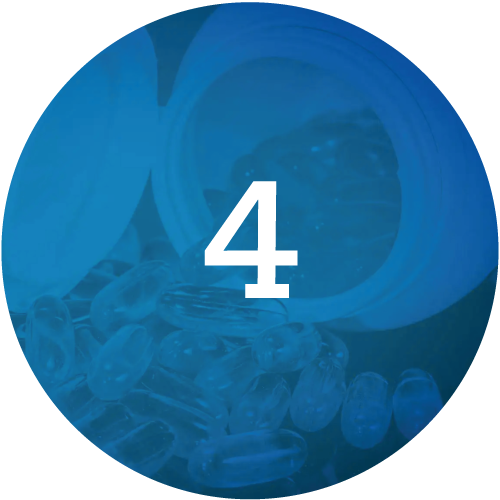
Hopefully the information in Part I was helpful for framing our conversation about Fibromyalgia & Chronic Fatigue Syndrome (FM/CFS). In this part, we will discuss treatment options. These are in no way meant to be exhaustive and any treatment plan is best discussed with your own personal health care provider.
Part Two:
Treatment Options from an Integrative & Functional Medicine Perspective
First & Foremost:
Begin by ruling out underlying diseases & system dysregulation
A thorough evaluation is critical at the outset to rule out underlying diseases and system dysregulation. This includes a comprehensive physical exam as well as laboratory evaluation. If you have low iron due to anemia, then neither your liver detoxification nor you brain cells will be operating optimally. If your thyroid is under functioning, as in Hypothyroidism, then your whole body will be in a kind of active hibernation state where energy production and utilization will be lowered.
This evaluation typically begins with your primary care provider but depending on the exam and laboratory findings, you may require a specialist evaluation as well. The symptom checklist from Part I is a helpful resource to categorize your complaints and begin your multimodal system analysis. Below is an example of a laboratory evaluation for CF/FMS but this listing in no way replaces seeing your primary health care provider for your own personal evaluation.
- Complete Blood Count
- Comprehensive Metabolic Panel
- Thyroid Levels (including TSH, FT4, FT3, RT3, thyroid antibodies)
- Inflammatory Markers & Autoimmune Markers (e.g. ESR, CRP, ANA, RF, ferritin, thyroid antibodies, celiac panel)
- Muscle Enzymes (CPK)
- Iron Panel
- Nutrient Analysis (e.g. Vitamin B12, D, A, folate, magnesium, selenium, zinc)
- Hormone Analysis (gender specific)
- Morning Cortisol
- Sugar Metabolism (e.g. fasting glucose, A1c, insulin, LDH)
- Sleep Study
- Advanced Testing: viral titers, tick born illness analysis, organic acid testing, advanced stool analysis, heavy metal analysis
Then:
Treatment Regimen
Just as the causes and associated triggers for CF/FMS are diverse, so are the treatments. The ultimate goal is to address the underlying root causes and let your body reboot itself. I will limit myself to five key areas to address in your overall treatment regimen:
- Sleep
- Diet
- Cellular Level Energy Production
- Other Modalities
- Graded Exercise
The ultimate goal is to address the underlying root causes and let your body reboot itself.
Sleep
One of the first areas for treatment is sleep. Sleep can be disordered in several ways. There can be disorders of sleep initiation, sleep maintenance and sleep architecture. Any one of these can result in non-restorative sleep:
Sleep Initiation refers to your ability to fall asleep.
Sleep Maintenance refers to your ability to stay asleep through the night.
Sleep Architecture refers to your body’s progressive cycles of sleep—moving cyclically through non rapid eye movement (NREM) and rapid eye movement (REM) sleep.
Improving Sleep Initiation
In a separate post, I have included recommendations for restoring proper sleep initiation with good habits or sleep hygiene. This is a useful resource for those who are not sure where to begin in addressing their sleep disturbance.
Improving Sleep Maintenance & Sleep Architecture
Once you have improved your ability to fall asleep, you may still need to improve your body’s ability to stay asleep (sleep maintenance) and achieve a satisfactory REM sleep (sleep architecture).
Natural Remedies
I recommend beginning with natural remedies due to their safety profile and ease of purchase. Below is a list of commonly used natural sleep agents:
- Magnesium Glycinate: 300–400 mg nightly
- Melatonin: 1–5 mg nightly (can do sustained release version 3–5mg or 1–3mg immediate release and 1 mg if awaken between 1:00–3:00am)
- Phosphatidyl Serine: 500mg nightly
- Herbals: valerian, passion flower, lemon balm
- L-Theanine: 200–400mg nightly
- Epsom Salt Bath: (1–4 cups) with or without Lavender Oil
- Lavender Oil Aroma Therapy
Sleep Medication
There are many medications on the market to help with sleep initiation or sleep maintenance. As always you must consult with your health care provider before starting any prescription medication. Mixing these medications can be very dangerous and is discouraged. One of the most popular sleep agents, Ambien, is only approved for use for 14 days; be careful and take prescription medications only under the direct supervision of you physician. I use these as adjuncts with the idea that once the sleeping patterns are improved, medications can and should be weaned off.
- Trazodone: 50mg nightly
- Belsomra: 10–20mg nightly
- Gabapentin: 100–600mg nightly
- Cyclobenzaprine: 5mg nightly or Tizanidine 4mg nightly
- Sonata: 5–10mg nightly or Zolpidem 5mg nightly
Diet
At the same time sleep is being addressed, your diet should be cleaned up. Foods are one of the leading causes of inflammation in the US, and data from the CDC shows that 50% of our current chronic diseases are related to consumption of processed foods. For this reason I recommend an anti-inflammatory diet. In the nutrition section of this website, I have included several medical grade diets from the Institute for Functional Medicine. Each individual will need to determine which diet is right for them. If you have lots of gas, bloating and GI issues related to food, the Elimination Diet would likely be your first choice. If you have a history chemical and toxin exposure, the Detox Food Plan would be your starting point. If you have plain old fatigue and energy issues or adrenal issues, the Energy Food Plan would be your starting point. The general idea is that you remove all inflammatory and processed foods, replace them with therapeutic foods specific for your condition, then allow your body time to heal.
At one of my recent conferences a pain management specialist from Pennsylvania was talking about his pain clinic. He starts all his pain patients on an anti-inflammatory diet to address their systemic inflammation and is achieving great results with pain management. Some patients even got off all their medications from diet changes alone.
Cellular Level Energy Production
Another area of dysfunction is that of energy supply and production at the cellular level. The most common way to address this is to supply the lacking nutrients to the cells in the expectation that once these are supplemented the cells’ powerhouse (mitochondria) will begin to work more efficiently. Below is a listing of the most common nutrients for energy production. Your initial lab evaluation will also guide the choice of nutrients needed.
- Acetyl L Carnitine: 1000–1500mg divided 2–3 times daily
- Coenzyme Q 10: 100–200mg twice
- D-Ribose: 5000mg three times a day for 3 weeks then twice daily
- EPA/DHA: 1000mg twice daily
- B Vitamins (esp. B12, folate, B6, Niacinamide)
- Lipid Exchange (replace or replenish the fatty acids of membranes)
- Magnesium: 300–500mg nightly (ideally glycinate form unless constipated)
- OTHERS: Alpha Lipoic Acid, N-Acetyl Cysteine, Acetyl Glutathione
Related Reading: Mito Food Plan
Pain Medication
For those with Fibromyalgia, pain treatment is an important part of the overall treatment regimen. The current medical literature shows that chronic narcotic use, through the opioid receptors in the brain, over time upregulate pain sensitivity. Their use is to be avoided and if you are already on narcotics you should find a skilled physician who can help you to safely wean off them. Since FM is largely a brain based neuroinflammatory disorder, nutraceuticals that treat this are your best option. Below is a listing of common ones used.
Nutraceuticals
- Curcumin: 1000mg 2–3 times daily (up to 5000mg total daily dosage)
- Boswellia: 500mg 2–3 times daily (up to 3000mg total daily dosage)
- EPA/DHA: 1000mg daily up to 5000mg daily
- DLPA: 500mg twice daily
- White Willow Bark: 500mg 2–3 times daily
Other Treatment Options
Other modalities for pain treatment that I’ve had success with include:
- Quell Device: estim device that down regulates the central pain receptors of the brain
- Acupuncture: helps with trigger points, myofascial pain and central pain
- Chiropractic: works at both a peripheral level (via Golgi apparatus and muscle spindle fibers) and central level (through feedback into the central nervous system)
- Myofascial Massage
- FAR IR: heats deeper tissues, improves lymphatic flow and improves detoxification through the skin.
- Near IR/LED Therapy: uses differing levels of light to penetrate the myofascial and muscular tissue levels to improve blood flow and tissue function
- PEMF: one device, the BEMR, has been studied extensively in Germany but other devices also work via affecting the body electromechanical system to help down regulate inflammation and pain receptors.
Graded Exercise
The last part of your FM/CFS regimen is graded exercise. Everyone has a threshold above which they will have muscle exhaustion and severe fatigue. For a marathon runner that level is extremely high. For CF/FMS patients that threshold could be going to the grocery store to buy food. For these patients, too little exercise results in deconditioning and too much results in extreme post exercise fatigue. After implementing all the above, THEN, you can start your graded exercise program. Start with just daily walking as tolerated. It may only be to the mailbox and back. After 10–12 weeks on the above regimen, increase your walking 1 minute per day as able. You can increase this more rapidly but the key is not to hit your threshold level. If you do you will regress. When you are walking 45–60 minutes a day, you can increase your intensity. Your first goal is to reach 10,000 steps a day. Once this goal is reached you can discuss with your health care provider what the next steps should be. This may take quite some time, so be patient.
Conclusion
Hopefully this two-part primer was helpful. Managing CF/FMS can be daunting and working with a skilled practitioner is paramount. The Institute for Functional Medicine’s website is a good starting place for finding a practitioner close to you who can help you navigate your path to wellness. Your own health care provider can also be a good starting point to resources in your local community. The supplements above can be purchased online. I’ve set up a link on my website to allow patients access to high grade supplements at a discounted rate. Review the nutrition tab on the website to learn more about choosing quality supplements and where to find them.
Since 2010, Richmond Integrative and Functional Medicine has been helping people to restore their health and hope with an integrative approach to conventional and alternative medicine that’s entirely science-backed. We at RIFM believe everyone is made for health. We offer a comprehensive, in-person patient membership program to ensure you get access to the care you need to thrive.





